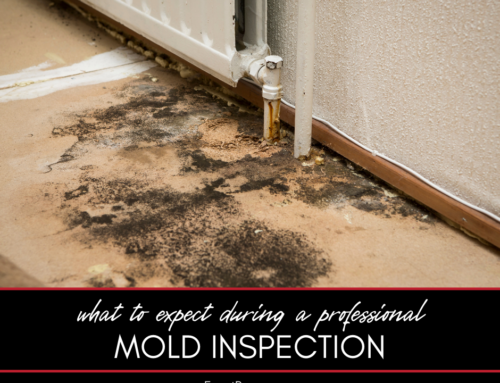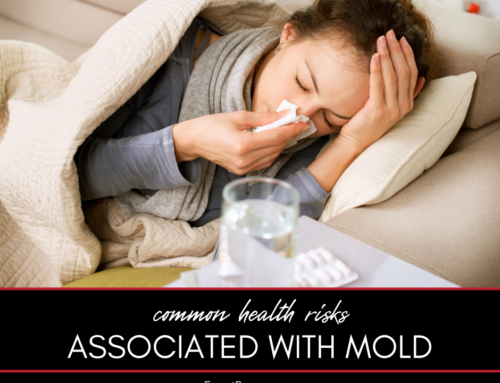Mold is a common household problem that can have serious implications for indoor air quality and your health. Understanding how mold affects your home and health is crucial for taking preventative measures and ensuring a safe living environment.
How Mold Can Affect Indoor Air Quality and Your Health
This comprehensive guide explores how mold impacts indoor air quality and health. It covers the following:
- What is mold?
- Common types of indoor mold
- How mold affects indoor air quality
- Health risks associated with mold exposure
- Symptoms of mold exposure
- Preventing mold growth in your home
- When to call a professional for mold remediation
Here’s a closer look at each.
What Is Mold?
Mold is a type of fungus that thrives in damp, warm, and humid environments. It can grow on various surfaces, including wood, drywall, carpet, and insulation. Mold reproduces by releasing spores into the air, which can settle on surfaces and form new mold colonies under the right conditions. While mold is a natural part of the environment, its presence indoors can pose serious health risks and damage your home.
Related: Expert advice on water damage, fire damage, mold and more
Common Types of Indoor Mold
Several types of mold are commonly found indoors, each with distinct characteristics and health effects.
Aspergillus: A common indoor mold that can cause allergic reactions and respiratory issues. It is often found in damp areas such as basements and bathrooms.
Cladosporium: This mold can grow in both warm and cool environments and is typically found on wood, carpets, and fabrics. It can cause allergic reactions and respiratory problems.
Stachybotrys (Black Mold): Known for its dark green or black color, this toxic mold produces mycotoxins that can cause severe health problems. It thrives in areas with consistent moisture, such as behind walls and under carpets.
Penicillium: Often found on water-damaged materials, this mold can spread rapidly and cause respiratory issues. It is commonly found on wallpaper, insulation, and fabrics.
How Mold Affects Indoor Air Quality
Mold significantly impacts indoor air quality by releasing spores and mycotoxins into the air. These airborne particles can be inhaled, leading to various health issues. Mold spores are microscopic and can easily become airborne when disturbed. Once in the air, they can spread throughout your home, contaminating HVAC systems, furniture, and other surfaces. Mycotoxins, toxic compounds produced by certain molds, can also become airborne and pose significant health risks. The presence of mold in your home can result in poor indoor air quality, which can exacerbate health problems, particularly for individuals with respiratory conditions, allergies, or weakened immune systems.
Related: Sewage backup in your home
Health Risks Associated With Mold Exposure
Exposure to mold can cause a range of health issues, depending on the type of mold and the duration of exposure.
Respiratory Problems: Mold spores can irritate the respiratory system, leading to symptoms such as coughing, wheezing, and shortness of breath. Individuals with asthma or chronic respiratory conditions may experience worsened symptoms.
Allergic Reactions: Mold is a common allergen that can trigger allergic reactions in sensitive individuals. Symptoms include sneezing, runny or stuffy nose, itchy eyes, and skin rashes.
Infections: Certain types of mold can cause infections, particularly in individuals with weakened immune systems. Fungal infections, such as aspergillosis, can develop when mold spores are inhaled and take hold in the lungs.
Toxic Mold Syndrome: Exposure to toxic molds, such as Stachybotrys, can cause toxic mold syndrome, leading to symptoms such as chronic fatigue, headaches, dizziness, nausea, cognitive difficulties, and respiratory problems.
Neurological Symptoms: Mycotoxins produced by toxic molds can affect the central nervous system, leading to symptoms such as headaches, memory loss, difficulty concentrating, and mood swings.
Symptoms of Mold Exposure
The symptoms of mold exposure can vary widely depending on the individual and the type of mold. Common symptoms include:
- Sneezing and coughing
- Nasal congestion
- Itchy and watery eyes
- Skin rashes
- Throat irritation
- Headaches
- Fatigue
- Shortness of breath
- Wheezing
Individuals with asthma, allergies, or weakened immune systems may experience more severe symptoms. Long-term exposure to mold can lead to chronic health problems, making it essential to address mold issues promptly.
Preventing Mold Growth in Your Home
Preventing mold growth involves controlling moisture levels in your home and taking proactive measures to reduce the risk of mold.
Control Humidity: Use dehumidifiers and air conditioners to maintain indoor humidity levels between 30% and 50%. Monitor humidity levels with a hygrometer and ensure proper ventilation in moisture-prone areas such as bathrooms, kitchens, and basements.
Fix Leaks Promptly: Repair leaks in plumbing, roofs, and windows as soon as they are detected. Even small leaks can create the moisture needed for mold growth.
Use Mold-Resistant Products: When building or renovating, consider using mold-resistant drywall, paint, and insulation to reduce the risk of mold growth.
Ensure Proper Ventilation: Use exhaust fans in bathrooms, kitchens, and laundry rooms to remove excess moisture. Open windows and doors when weather permits to improve air circulation.
Clean and Maintain: Regularly clean and inspect areas prone to moisture, such as showers, sinks, and basements. Use mold-killing products to clean surfaces where mold is likely to grow.
When to Call a Professional for Mold Remediation
Despite your best efforts, mold can sometimes still develop. If you discover mold in your home, especially if it covers a large area (greater than 10 square feet), it’s essential to call a professional for mold remediation. Professionals have the expertise and equipment to safely and effectively remove mold and address the underlying moisture issues. They can also conduct thorough inspections to ensure all mold is eliminated and provide recommendations to prevent future growth. Professional remediation ensures that the mold is completely removed, protecting your home and health.
Related: How does homeowners insurance work after a disaster?
FAQ About Mold and Indoor Air Quality
Check out these commonly asked questions about mold and indoor air quality. If you don’t see your question here, please call our office and we’ll find you the answers you need.
How Can I Monitor Humidity Levels in My Home?
You can monitor humidity levels in your home using a hygrometer, which is an inexpensive device available at most hardware stores. Aim to keep indoor humidity levels between 30% and 50% to prevent mold growth.
What Should I Do If I Find Mold in My Home?
If you find mold in your home, clean small areas with a mixture of water and bleach or a commercial mold cleaner. For larger infestations, it’s best to call a professional for mold remediation to ensure thorough and safe removal.
Can Mold Cause Long-Term Health Problems?
Yes, prolonged exposure to mold can lead to long-term health problems, including chronic respiratory issues, asthma, and neurological problems. Addressing mold issues promptly is crucial to prevent these health risks.
How Can I Prevent Mold Growth in Humid Climates?
In humid climates, use air conditioners and dehumidifiers to control indoor humidity levels. Ensure proper ventilation in moisture-prone areas and use mold-resistant products when building or renovating.
Why Is Professional Mold Remediation Important?
Professional mold remediation is important because it ensures that all mold is thoroughly removed, including hidden mold that may not be visible. Professionals have the expertise and equipment to safely and effectively eliminate mold, preventing further growth and protecting your health.
Do You Need a Disaster Remediation Expert in Washtenaw County or Jackson County?
If your home has already been damaged, we can help. Check out our services and call Exact Recon for your free disaster remediation quote today. We offer:
- Water damage restoration
- Fire damage restoration
- Mold removal and remediation
- Fire and smoke restoration
- Sewer cleanup and disinfecting
- Reconstruction
- Wind and storm damage repair









